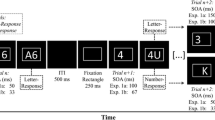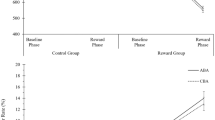Abstract
People exhibit a remarkable ability to both maintain controlled focus on executing a single task and flexibly shift between executing several tasks. Researchers studying human multitasking have traditionally focused on the cognitive control mechanisms that allow for such stable and flexible task execution, but there has been a recent interest in how cognitive control mechanisms drive the decision of task selection. The present research operationalizes a foraging analogy to investigate what factors drive the decision to either exploit task repetitions or explore task switches. A novel paradigm—reward-based voluntary task switching—ascribes point values to tasks where the overall goal is to accumulate points as quickly as possible. The reward structure generally rewards switching tasks, thereby juxtaposing the motivation to gain increased reward (by exploring task switches) against the motivation to perform quickly (by exploiting task repetitions). Results suggest that people are highly sensitive to changes in both reward and effort demands when making task selections, and that the task selection process is efficient and flexible. We argue that a cost–benefit mechanism might underlie decisions in multitasking contexts, whereby people compute task selections based on both the reward available for selecting a task and the effort necessary to execute a task.




Similar content being viewed by others
Notes
While Fröber and Dreisbach (2016), among others, have implemented reward for task execution during VTS, to our knowledge, rVTS is a novel approach in that it is the first to implement rewards for task selection in a VTS environment.
Participants also completed the behavioral inhibition/activation system questionnaire (BIS/BAS; Carver & White, 1994), with the idea being that reward sensitivity might predict behavior in rVTS. We also collected age and gender demographic information. However, none of these factors proved to be significant predictors of task selections in rVTS and are not included in the analyses presented here.
We stress that, in rVTS, participants only ever faced possible reductions to prospective gains and never true loss of their acquired resources (i.e., points); the latter is the true conception of “loss” invoked by prospect theory (Kahneman & Tversky, 1979).
References
Arrington, C. M. (2008). The effect of stimulus availability on task choice in voluntary task switching. Memory & Cognition, 38, 991–997.
Arrington, C. M., & Logan, G. D. (2004). The cost of a voluntary task switch. Psychological Science, 15, 610–615.
Arrington, C. M., & Logan, G. D. (2005). Voluntary task switching: Chasing the elusive homunculus. Journal of Experimental Psychology. Learning, Memory, and Cognition, 31, 683–702.
Arrington, C. M., Reiman, K. M., & Weaver, S. M. (2014). Voluntary task switching. In J. A. Grange & G. Houghton (Eds.), Task Switching and Cognitive Control (pp. 117–136). New York: Oxford University Press.
Arrington, C. M., Weaver, S. M., & Pauker, R. L. (2010). Stimulus-based priming of task choice during voluntary task switching. Journal of Experimental Psychology. Learning, Memory, and Cognition, 36, 1060–1067.
Bates, D., Maechler, M., Bolker, B., & Walker, S. (2015). Fitting linear mixed-effect models using lme4. Journal of Statistical Software, 67, 1–48.
Botvinick, M., & Braver, T. (2015). Motivation and cognitive control: From behavior to neural mechanism. Psychology, 66, 83–113.
Botvinick, M. M., & Cohen, J. D. (2014). The computational and neural basis of cognitive control: Charted territory and new frontiers. Cognitive Science, 38, 1249–1285.
Botvinick, M. M., Niv, Y., & Barto, A. C. (2009). Hierarchically organized behavior and its neural foundations: A reinforcement learning perspective. Cognition, 113, 262–280.
Carver, C. S., & White, T. L. (1994). Behavioral inhibition, behavioral activation, and affective responses to impending reward and punishment: The BIS/BAS scales. Journal of Personality and Social Psychology, 67, 319–333.
Cohen, J. D., Dunbar, K., & McClelland, J. L. (1990). On the control of automatic processes: A parallel distributed processing account of the Stroop effect. Psychological Review, 97, 332–361.
Dayan, P., & Niv, Y. (2008). Reinforcement learning: The good, the bad and the ugly. Current Opinion in Neurobiology, 18, 185–196.
Demanet, J., Verbruggen, F., Liefooghe, B., & Vandierendonck, A. (2010). Voluntary task switching under load: Contribution of top-down and bottom-up factors in goal-directed behavior. Psychonomic Bulletin & Review, 17, 387–393.
Fröber, K., & Dreisbach, G. (2016). How sequential changes in reward magnitude modulate cognitive flexibility: Evidence from voluntary task switching. Journal of Experimental Psychology. Learning, Memory, and Cognition, 42, 285–295.
Gilbert, S. J., & Shallice, T. (2002). Task switching: A PDP model. Cognitive Psychology, 44, 297–337.
Holroyd, C. B., & McClure, S. M. (2015). Hierarchical control over effortful behavior by rodent medial frontal cortex: A computational model. Psychological Review, 122, 54–83.
Holroyd, C. B., & Yeung, N. (2011). An integrative theory of anterior cingulate cortex function: Option selection in hierarchical reinforcement learning. In R. B. Mars, J. Sallet, M. F. S. Rushworth, & N. Yeung (Eds.), Neural basis of motivational cognitive control (pp. 333–349). Cambridge, Massachusetts: The MIT Press.
Hommel, B. (2009). Action control according to TEC (theory of event coding). Psychological Research, 73, 512–526.
Inzlicht, M., & Schmeichel, B. J. (2012). What is ego depletion? Toward a mechanistic revision of the resource model of self-control. Perspectives on Psychological Science, 7, 450–463.
Kahneman, D., & Tversky, A. (1979). Prospect theory: An analysis of decision under risk. Econometrica, 47, 263–291.
Kessler, Y., Shencar, Y., & Meiran, N. (2009). Choosing to switch: Spontaneous task switching despite associated behavioral costs. Acta Psychologica, 131, 120–128.
Kiesel, A., Steinhauser, M., Wendt, M., Falkenstein, M., Jost, K., Philipp, A. M., & Koch, I. (2010). Control and interference in task switching—A review. Psychological Bulletin, 136, 849–874.
Kool, W., & Botvinick, M. (2014). A labor/leisure tradeoff in cognitive control. Journal of Experimental Psychology: General, 143, 131–141.
Kool, W., Gershman, S. J., & Cushman, F. A. (2017). Cost-benefit arbitration between multiple reinforcement-learning systems. Psychological Science, 28, 1–13.
Kool, W., McGuire, J. T., Rosen, Z. B., & Botvinick, M. M. (2010). Decision making and the avoidance of cognitive demand. Journal of Experimental Psychology: General, 139, 665–682.
Kool, W., Shenhav, A., & Botvinick, M. M. (2017b). Cognitive Control as Cost-Benefit Decision Making. In T. Egner (Ed.), The Wiley Handbook of Cognitive Control (pp. 167–189). Hoboken: John Wiley & Sons Inc.
Kurzban, R., Duckworth, A., Kable, J. W., & Myers, J. (2013). An opportunity cost model of subjective effort and task performance. Behavioral and Brain Sciences, 36, 661–679.
Liefooghe, B., Demanet, J., & Vandierendonck, A. (2010). Persisting activation in voluntary task switching: It all depends on the instructions. Psychonomic Bulletin & Review, 17, 381–386.
Logan, G. D., & Gordon, R. D. (2001). Executive control of visual attention in dual-task situations. Psychological Review, 108, 393–434.
Mayr, U., & Bell, T. (2006). On how to be unpredictable: Evidence from the voluntary task-switching paradigm. Psychological Science, 17, 774–780.
Meiran, N. (2000). Reconfiguration of stimulus task sets and response task sets during task switching. In S. Monsell & J. Driver (Eds.), Control of Cognitive Processes: Attention and Performance XVIII (pp. 377–399). Cambridge: MIT Press.
Miller, E. K., & Cohen, J. D. (2001). An integrative theory of prefrontal cortex function. Annual Review of Neuroscience, 24, 167–202.
Orquin, J. L., & Loose, S. M. (2013). Attention and choice: A review on eye movements in decision making. Acta Psychologica, 144, 190–206.
R Core Team (2017). R: A language and environment for statistical computing. R Foundation for Statistical Computing, Vienna, Austria. https://www.R-project.org/.
Rangel, A., Camerer, C., & Montague, P. R. (2008). A framework for studying the neurobiology of value-based decision making. Nature Reviews Neuroscience, 9, 545–556.
Rogers, R. D., & Monsell, S. (1995). Costs of a predictable switch between simple cognitive tasks. Journal of Experimental Psychology: General, 124, 207–231.
Shenhav, A., Botvinick, M. M., & Cohen, J. D. (2013). The expected value of control: An integrative theory of anterior cingulate cortex function. Neuron, 79, 217–240.
Shenhav, A., Musslick, S., Lieder, F., Kool, L., Griffiths, T. L., Cohen, J. D., & Botvinick, M. M. (2017). Toward a rational and mechanistic account of mental effort. Annual Review of Neuroscience, 40, 99–124.
Vandierendonck, A., Demanet, J., Liefooghe, B., & Verbruggen, F. (2012). A chain-retrieval model for voluntary task switching. Cognitive Psychology, 65, 241–283.
Vandierendonck, A., Liefooghe, B., & Verbruggen, F. (2010). Task switching: Interplay of reconfiguration and interference control. Psychological Bulletin, 136, 601–626.
Westbrook, A., & Braver, T. S. (2015). Cognitive effort: A neuroeconomic approach. Cognitive, Affective & Behavioral Neuroscience, 15, 395–415.
Westbrook, A., & Braver, T. S. (2016). Dopamine does double duty in motivating cognitive effort. Neuron, 89, 695–710.
Westbrook, A., Kester, D., & Braver, T. S. (2013). What is the subjective cost of cognitive effort? Load, trait, and aging effects revealed by economic preference. PLoS ONE, 22, e68210.
Yantis, S., & Jonides, J. (1990). Abrupt visual onsets and selective attention: Voluntary versus automatic allocation. Journal of Experimental Psychology: Human Perception and Performance, 16, 121–134.
Yeung, N. (2010). Bottom-up influences on voluntary task switching: The elusive homunculus escapes. Journal of Experimental Psychology. Learning, Memory, and Cognition, 36, 348–362.
Yeung, N., & Monsell, S. (2003). Switching between tasks of unequal familiarity: The role of stimulus-attribute and response-set selection. Journal of Experimental Psychology: Human Perception and Performance, 29, 455–469.
Zajonc, R. B. (2001). Mere exposure: A gateway to the subliminal. Current Directions in Psychological Science, 10, 224–228.
Author information
Authors and Affiliations
Corresponding author
Ethics declarations
Funding
While this research was not supported by a grant from a funding agency, Kate Arrington was employed by the US National Science Foundation (NSF) as a Visiting Scientist, Engineer, or Educator (VSEE) and her time spent in writing the manuscript and mentoring the research was supported by the NSF as part of her VSEE position.
Conflict of interest
We declare no conflicts of interest in the conduct or reporting on the present research. We agree to make raw data available if requested.
Ethical approval
All procedures performed in studies involving human participants were in accordance with the ethical standards of the institutional and/or national research committee and with the 1964 Helsinki declaration and its later amendments or comparable ethical standards. The protocols for these experiments were approved by the Lehigh University Institutional Review Board.
Informed consent
Informed consent was obtained from all individual participants included in the study.
Rights and permissions
About this article
Cite this article
Braun, D.A., Arrington, C.M. Assessing the role of reward in task selection using a reward-based voluntary task switching paradigm. Psychological Research 82, 54–64 (2018). https://doi.org/10.1007/s00426-017-0919-x
Received:
Accepted:
Published:
Issue Date:
DOI: https://doi.org/10.1007/s00426-017-0919-x




